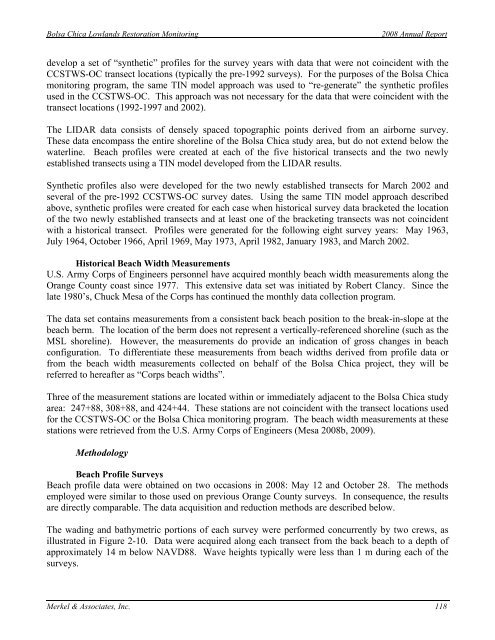2008 Annual Monitoring Report (pdf 10.9MB) - Bolsa Chica ...
2008 Annual Monitoring Report (pdf 10.9MB) - Bolsa Chica ...
2008 Annual Monitoring Report (pdf 10.9MB) - Bolsa Chica ...
Create successful ePaper yourself
Turn your PDF publications into a flip-book with our unique Google optimized e-Paper software.
<strong>Bolsa</strong> <strong>Chica</strong> Lowlands Restoration <strong>Monitoring</strong><br />
<strong>2008</strong> <strong>Annual</strong> <strong>Report</strong><br />
develop a set of “synthetic” profiles for the survey years with data that were not coincident with the<br />
CCSTWS-OC transect locations (typically the pre-1992 surveys). For the purposes of the <strong>Bolsa</strong> <strong>Chica</strong><br />
monitoring program, the same TIN model approach was used to “re-generate” the synthetic profiles<br />
used in the CCSTWS-OC. This approach was not necessary for the data that were coincident with the<br />
transect locations (1992-1997 and 2002).<br />
The LIDAR data consists of densely spaced topographic points derived from an airborne survey.<br />
These data encompass the entire shoreline of the <strong>Bolsa</strong> <strong>Chica</strong> study area, but do not extend below the<br />
waterline. Beach profiles were created at each of the five historical transects and the two newly<br />
established transects using a TIN model developed from the LIDAR results.<br />
Synthetic profiles also were developed for the two newly established transects for March 2002 and<br />
several of the pre-1992 CCSTWS-OC survey dates. Using the same TIN model approach described<br />
above, synthetic profiles were created for each case when historical survey data bracketed the location<br />
of the two newly established transects and at least one of the bracketing transects was not coincident<br />
with a historical transect. Profiles were generated for the following eight survey years: May 1963,<br />
July 1964, October 1966, April 1969, May 1973, April 1982, January 1983, and March 2002.<br />
Historical Beach Width Measurements<br />
U.S. Army Corps of Engineers personnel have acquired monthly beach width measurements along the<br />
Orange County coast since 1977. This extensive data set was initiated by Robert Clancy. Since the<br />
late 1980’s, Chuck Mesa of the Corps has continued the monthly data collection program.<br />
The data set contains measurements from a consistent back beach position to the break-in-slope at the<br />
beach berm. The location of the berm does not represent a vertically-referenced shoreline (such as the<br />
MSL shoreline). However, the measurements do provide an indication of gross changes in beach<br />
configuration. To differentiate these measurements from beach widths derived from profile data or<br />
from the beach width measurements collected on behalf of the <strong>Bolsa</strong> <strong>Chica</strong> project, they will be<br />
referred to hereafter as “Corps beach widths”.<br />
Three of the measurement stations are located within or immediately adjacent to the <strong>Bolsa</strong> <strong>Chica</strong> study<br />
area: 247+88, 308+88, and 424+44. These stations are not coincident with the transect locations used<br />
for the CCSTWS-OC or the <strong>Bolsa</strong> <strong>Chica</strong> monitoring program. The beach width measurements at these<br />
stations were retrieved from the U.S. Army Corps of Engineers (Mesa <strong>2008</strong>b, 2009).<br />
Methodology<br />
Beach Profile Surveys<br />
Beach profile data were obtained on two occasions in <strong>2008</strong>: May 12 and October 28. The methods<br />
employed were similar to those used on previous Orange County surveys. In consequence, the results<br />
are directly comparable. The data acquisition and reduction methods are described below.<br />
The wading and bathymetric portions of each survey were performed concurrently by two crews, as<br />
illustrated in Figure 2-10. Data were acquired along each transect from the back beach to a depth of<br />
approximately 14 m below NAVD88. Wave heights typically were less than 1 m during each of the<br />
surveys.<br />
Merkel & Associates, Inc. 118






